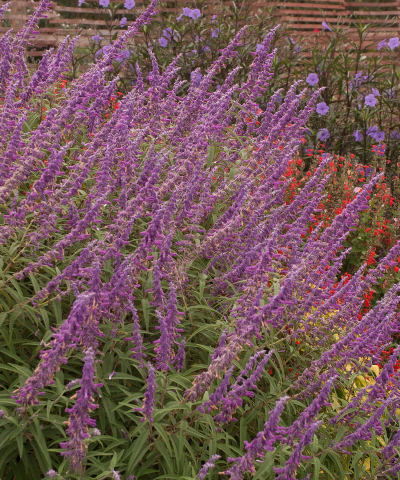Autumn is on the way, and soon area landscapes will be aglow with vibrant oranges, reds and yellows. So, in the middle of this visually simulating mix of fiery colors, why not add purple?
Mexican bush sage (Salvia leucantha) is just the kind of plant to cool off the hot fall colors with its wide swaths of pleasing purple blossom spikes.
Compared to other salvias, this plant might seem shy. Many annual and perennial salvias can’t wait to get blooming in the spring and summer. But Mexican bush sage waits.
Only when the long hot summer, after melting the flower border and wearing out its welcome with gardeners, is winding down does Mexican bush sage come out to play with displays of long, flowing stalks dipped in the violet end of the spectrum that can last deep into the fall.
As its name suggests, this salvia is native to Mexico, but it is still reliably hardy enough to weather typical Cary winters. This perennial performs best in well-drained soil situated in a bright location — if it doesn’t fully bask in the sun’s rays for at least six hours a day, its branches tend to stretch long and leggy.
It is drought tolerant, making it a good candidate for xeriscape gardens, which require minimal moisture, or large container plantings. However, a happy Mexican bush sage can grow up to 4 feet tall and about as wide, so place it in a spot where it won’t bully other plants.
Much of the eye-catching purple associated with Mexican bush sage blossoms comes from the fuzzy calyces (outer coverings) of the blooms, and they persist long after the flowers fade and fall off.
The small blooms typically glimmer in a handsome, contrasting white, but there are exceptions. For instance, the cultivar ‘All Purple’ (also known as ‘Midnight’) lives up to its name with amethyst flowers complementing the embracing purple calyces. ‘Santa Barbara’ puts on a similar purple-on-purple show, and as a bonus, it is more compact than other Mexican bush sages.
Even if you only buy one Mexican bush sage, don’t worry about it being lonely. This late-flowering beauty is a nectar-laced magnet for bees, butterflies and lingering hummingbirds. Plant it, and they will come.
But as much as this bush in bloom is enjoyed by wildlife on the wing, don’t think such bliss also translates into unwanted attention from deer — Mexican bush sage will not be found on Bambi’s Most Preferred list for garden grazing.
L.A. Jackson is the former editor of Carolina Gardener Magazine. Want to ask L.A. a question about your garden? Contact him by email at: lajackson1@gmail.com.
To Do in the Garden
September
- Add even more colorful appeal to the fall flower garden by also including such eye-catching plants as asters, calendulas, dusty millers, ornamental kales, flowering cabbages and pansies.
- To prevent a fungal disease known as scab from raising its ugly head, keep leaves and fallen fruit raked up from under crabapple trees.
- While the leaves are still on your woody ornamentals, look for dead, diseased or damaged limbs and prune them off.
- Begin bringing in house plants before nighttime temperatures start to cool into the 50s. Repot if necessary, prune unsightly foliage and check carefully for unwanted insects looking for winter havens.
- Keep the bird feeder stocked because activity will increase with the coming of fall. Continue cleaning out the bird bath and adding fresh water weekly.
October
- Whether you grow or buy pumpkins for Halloween decorations, remember that they will last longer if they still have a few inches of stem attached. Keeping the rind intact will also help, meaning a carved pumpkin will have a shorter show-off life.
- Before herbaceous perennials are nipped to the ground by cold weather, set markers beside them so they won’t accidentally be disturbed or dug up during the busy spring planting season next year.
- Check the wires on supports and identification tags of spring-planted woody ornamentals to make sure they have not started to cut into limbs or trunks that have grown during the summer.
- Any shrubs or small trees that are scheduled to be relocated next year in the late winter should be root pruned now to make the future move easier on both the plant and the planter.
- Don’t be too quick to cut down and discard ornamental grass plumes, as they can not only add their special beauty to the winter garden, but they can also accentuate indoor arrangements.
Timely Tip
An easy way to prevent dropping leaves from filling the water garden is to spread a plastic netting across the surface. DeWitt, Pondmaster and Atlantic are three common brands of netting specifically made for water gardens.
Clean the screen once a week and after autumn’s leaf fall is finished. Remove it, if you want, but if you have fish, keep in mind that this barrier is also a good way to prevent herons, raccoons and other hungry critters from turning the pond into their watery dinner table.
Worried about this netting visually junking up your pristine pool? Pick a dark colored screen and position it just below the surface of the water to help it blend in better.






